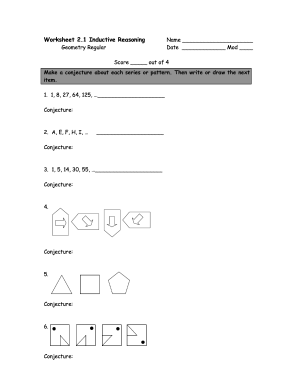Loading

Get Mentor High Worksheet 2.1 Inductive Reasoning
How it works
-
Open form follow the instructions
-
Easily sign the form with your finger
-
Send filled & signed form or save
How to fill out the Mentor High Worksheet 2.1 Inductive Reasoning online
The Mentor High Worksheet 2.1 Inductive Reasoning is an essential tool for understanding patterns and making conjectures. This guide will help you fill out the worksheet online, ensuring you complete it accurately and efficiently.
Follow the steps to complete the worksheet effectively.
- Click the ‘Get Form’ button to access the worksheet and open it for editing.
- Begin with the first item in the series: 1, 8, 27, 64, 125. Make a conjecture about the pattern and write or draw the next item in the space provided.
- For the second item, which includes letters, identify the pattern and provide your conjecture in the designated area.
- Proceed to item three, 1, 5, 14, 30, 55. Again, analyze the sequence to predict the next number and write your conjecture.
- Items four, five, and six also require you to determine the conjectures based on the provided patterns or sequences. Fill these out accordingly.
- Items seven through ten ask you to assess statements regarding geographical locations. Indicate whether each statement is true or false and provide counterexamples if false.
- For items eleven through fifteen, evaluate various mathematical statements and provide your reasoning for true or false designations, including counterexamples if necessary.
- Complete items sixteen and seventeen by finalizing the conjectures based on the mathematical principles described.
- Once you have filled out all sections, be sure to review your responses for accuracy.
- You can then save your work, download the form, print it, or share it as required.
Complete your worksheets online to enhance your learning experience!
Good examples of inductive reasoning include observing that ice melts in warm temperatures and concluding that heat causes melting. Another is noticing that a specific style of teaching leads to improved understanding, leading one to advocate for that style. The Mentor High Worksheet 2.1 Inductive Reasoning can effectively guide you through various scenarios.
Industry-leading security and compliance
US Legal Forms protects your data by complying with industry-specific security standards.
-
In businnes since 199725+ years providing professional legal documents.
-
Accredited businessGuarantees that a business meets BBB accreditation standards in the US and Canada.
-
Secured by BraintreeValidated Level 1 PCI DSS compliant payment gateway that accepts most major credit and debit card brands from across the globe.


